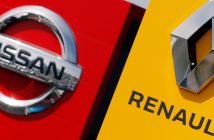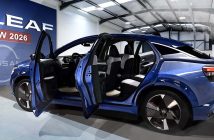+++ ELECTRIC cars such as the Nissan Leaf may look no different from the standard family runaround. But the new materials that go into them could revolutionize the market for metals used in the industry, opening up a new field for commodities investors. “We identified electric vehicles as an area where we are at an inflection point for demand”, said Duncan Goodwin, portfolio manager of the Baring Global Resources Fund. Around 12 percent of the fund’s $378.2 million in assets is exposed to materials that are used in electric vehicles. It has investments in New York-listed Albemarle and Australia’s Orocobre, 2 companies producing lithium, a key element in electric car batteries. Shares in both companies have risen sharply this year. Governments, keen to push growth in electric cars in a bid to meet their carbon emissions targets, are tempting consumers with perks like subsidies, free parking and tax breaks. Growth in the market is in turn creating an opportunity for commodities investments currently estimated at $235 billion. But it is not a simple one-way bet. Predicting how much of any metal will be needed to meet demand for electric vehicles in the longer term is tough and advances in battery technology could alter the mixture. Getting drivers to adopt electric cars remains a challenge – the need to charge them up frequently and time taken to do so have put off many potential buyers. Still, concerns over the pollution created by diesel-powered vehicles mean that electric car prototypes dominated the Paris car show last week. The number of electric and hybrid vehicles on the road worldwide surpassed 1 million last year, according to the International Energy Agency. While estimates vary, IHS Automotive expects electric vehicles to represent nearly 4 percent of all light vehicles worldwide by 2020, equivalent to 3.9 million cars, up from just over 14,000 in 2010. So what sits below the bonnet in these vehicles? Most electric car batteries use lithium nickel manganese cobalt oxide (NMC) cathodes and graphite anodes. “Rare earth” metals dysprosium, neodymium and terbium, chiefly mined in China by companies including Xiamen Tungsten and China Minmetals Rare Earth, are used in some electronic components of the motor. “It’s clear that electric cars from today’s point of view will have lithium ion-based batteries”, said Horst Friedrich, director of Germany’s Institute of Vehicle Concepts. “We’re talking about lithium, and… metals like cobalt, iron phosphate, rare earth elements”. Much of the world’s lithium comes from an area called the “Lithium triangle” in Chile, Argentina and Bolivia. Mining it is an increasingly lucrative business. Prices of battery grade lithium in China, the biggest lithium ion battery producer, surged to above $20,000 a tonne this summer, nearly three times higher than a year earlier, as demand grew. “The lithium industry is going from 160,000 tonnes of LCE (lithium carbonate equivalent) today to at least 260,000 tonnes by 2020”, said Simon Moores, managing director of Benchmark Mineral Intelligence. Albemarle is investing an undisclosed sum to boost its production of battery-grade lithium salts to try to supply half of that projected demand growth, said John Mitchell, the president of Albemarle’s lithium unit. Australia’s Lithium Power International is preparing its Maricunga Salar project in northern Chile to be able to ship lithium directly to China for use in electric vehicles, and aims to be in production by 2019-2020. Australian rival Orocobre, whose share price has risen by more than 50 percent this year, has nearly completed a scoping study with the aim of at least doubling production capacity over the next 2 years at a facility in Argentina. Among South American companies, Chile’s SQM announced this month that it was investing $30 million to boost its lithium hydroxide capacity by 7,500 tonnes. “The market penetration of electric vehicles in the automotive market will have a significant impact on lithium demand”, it said. Critics caution against expecting shortages of lithium as there is an abundance of it in the earth’s crust. Others warn against jumping too quickly into smaller companies that may not produce the high grade lithium needed for the batteries. “It’s very much buyer beware, it’s a fast-moving market, and there is a large degree of ignorance about it”, Finntech analyst Martin Potts said, adding that graphite could be more interesting for investors. China dominates the sector for graphite, used in anodes. Benchmark Mineral Intelligence expects 150,000-170,000 tonnes of extra anode grade graphite will be needed by 2020, worth an extra $1.125-1.275 billion. Canada’s Eagle Graphite said while the impact of electric vehicles on its business is still to be felt, when global production hits around 1 million cars per year, the draw on graphite supplies will become significant. “The more forward-looking manufacturers are rightly becoming concerned about long term supply”, its CEO Jamie Deith said. “Not only is there the question of producing enough graphite, but the fact that China accounts for 100 percent of natural graphite anodes today is an additional concern. The battery industry has to diversify sources”. Meanwhile cobalt prices, up 16 percent this year, are expected to rise another 45 percent by 2020. The U.S. Defense Logistics Agency starting to stockpile cobalt compounds highlights their importance. Sherritt International (S.TO), one of the largest cobalt producers, said it is set to increase cobalt production at its Ambatovy mine in Madagascar in line with nickel output. As cobalt is mined largely as a by-product of other metals such as nickel and copper, it is hard for producers to crank up output in response to higher demand, it said. That lack of supply elasticity could push prices higher. Not all metals used in car batteries have a rosy future. Demand for manganese, a common component in steel, is expected to remain weak in the near term as the steel sector suffers. Predicting how much of any given metal would be needed to meet demand for electric vehicles in the longer term is tough and advances in battery technology could alter the amounts. Metals such as nickel, cobalt and manganese may not be needed in batteries such as the lithium sulfur battery being developed by Oxis Energy, based in the English city of Oxford. Also in the background are green vehicle technologies, most notably hydrogen fuel cells, being mooted as possible rivals to batteries. But developing new technology to the point where it can be commercialized takes time. “We consider the risk of substitution of lithium to be very low”, said CRU Group’s Julia Ralph. Guiding the silent, top-of-the-range Leaf around a showroom complex at Nissan London West, salesman Keith Almansury says education is the key to driving growth in the segment. “If people don’t love electric cars, it’s because they don’t know about electric cars”, he said, flagging up benefits including environmental friendliness, savings on fuel and servicing, and free parking. “But above all, it’s just a really nice drive”. +++
+++ Henrik FISKER had an interesting run with Fisker Automotive, offering the acclaimed Karma before applying for bankruptcy in November 2012. But now he’s back with a brand-new company and new ideas. The Fisker Karma was considered the world’s first premium electric car with a range extender, but since all the company’s assets were acquired by a Chinese auto-parts maker, Mr. Fisker had to start from scratch with his new business. Good thing he still owned the trademark for the Fisker brand, then. Now, the Danish designer has just announced Fisker Inc., an American electric vehicle automotive company that’s based in California. With his new venture, Fisker wants to develop unique, high-performance, electric vehicles in order “break new barriers within the automotive industry”. Scheduled to showcase its first product in the second half of 2017, the vehicle will feature a patented battery that will deliver a significantly longer life and range than any battery currently on the market – according to Fisker, at least. Having learned from its past mistakes, this time, the company won’t rely on an independent battery provider, as Fisker Nanotech, the battery arm of Fisker Inc., will pioneer the development of these game-changing batteries. “We have really been working in stealth mode. For the last 2 years, I have been looking at battery technologies and wanted to see if there was something that could really give us a new paradigm. We had the strategy of developing the technology as fast as possible without getting tied down to a large organization, which would hold us back. Now we have the technology that nobody else has. And there is nobody even close to what we are doing out there”, said Fisker in an interview with Bloomberg. Apart from that, Fisker says the automobile will have never-before-seen design features, as well as more legroom and headroom than any of its competitors. Moreover, Fisker Inc. won’t make just one product and call it a day. In addition to launching a first-of-its-kind premium vehicle, the company is also developing a mass-market affordable car that will cost less than its competitors, while boasting a longer electric range. +++
+++ Just like the F-150, the new FORD Expedition is set to adopt an aluminum body, reports the Detroit Free Press. The company confirmed the news while recently speaking to investors saying that the aluminum-bodied Expedition will arrive by 2018. Just like the current model, the new Ford Expedition will be constructed at the firm’s Kentucky Truck Plant. which also produces the latest aluminum-clad Super Duty. Although Ford didn’t confirm any additional details about the new Expedition, it is expected to create additional jobs at the facility. Current speculation suggests that the next-generation Expedition will be powered by Ford’s 3.5-liter EcoBoost V6. Mated to this engine will be a 10-speed automatic transmission in place of the old six-speed of the outgoing model. There’s a possibility that a smaller 2.7-liter variant could be offered after launch. Each year, Ford sells approximately 40,000 Expeditions, about half the number of Chevrolet Tahoes sold annually. Following its extensive update however, there’s a good chance the Blue Oval will see delivery figures rise. +++
+++ MERCEDES could join the Formula E championship for electric racing cars in the 2018/19 season, after signing an agreement with the series organisers. Brackley-based Mercedes-Benz Grand Prix, which runs the German brand’s all-conquering Formula One team, has an option to join Formula E for its fifth season, which will begin in autumn 2018. That’s set to be a milestone season for the championship, when the current practice of drivers swapping cars mid-race is ended in favour of batteries that will last the full one-hour duration of each event. Currently, 10 teams make up the Formula E grid, but the FIA has authorised an expansion to 12 outfits for 2018 and Mercedes could be one of the two new arrivals. Recently, BMW announced a technical partnership with the Andretti team, while Jaguar, Renault, Audi and DS all already have a presence in the series. Mercedes could use its potential Formula E entry to promote its new range of electric vehicles, under the name ‘EQ’. Alejandro Agag, CEO of Formula E, said: “We are delighted to confirm that we have reserved one of our two new entries in season five for Mercedes. Formula E wants to become the platform where car manufacturers test and develop the technologies they will then introduce on their road cars. Having the chance to include a brand like Mercedes in our championship in the future would be a major boost to achieve that objective. Toto Wolff, head of Mercedes motorsport, said: “We’ve been watching the growth of Formula E with great interest. At the current time, we are looking at all the options available in the future of motor racing and we are very pleased with an agreement that secures us an opportunity to enter the series in season five. Electrification will play a major role in the future of the automotive industry – racing has always been a technology R&D platform for the motor industry and this will make Formula E very relevant in the future”. Formula E’s third season begins this weekend (October 8-9) with a race on the streets of Hong Kong. +++
+++ NISSAN will be hot on the heels of the new Skoda Kodiaq with a more powerful X-Trail next year. A new range-topping diesel engine will help to boost the SUV in the face of fresher rivals, as will minor styling tweaks and cabin updates for the 2017 model year. In an interview at the 2016 Paris Motor Show with Auto Express, former UK MD and recently appointed Vice President of Nissan Europe East James Wright revealed that a new 190 hp diesel engine will be brought to European showrooms to complement the current range of 1.6-litre units. The 2.0-litre four cylinder diesel engine is an engine offered in other markets, but will need to be upgraded for Euro 6 standards. Wright claims that the addition is about offering “something richer” in the current SUV lineup as that’s what buyers are demanding. He cites the fact that over 40 per cent of X-Trails sold are top-spec Tekna grades and come fitted with four-wheel drive. The next logical step, therefore, is to introduce a range-topping engine and boost sales further. Currently, the most powerful X-Trail you can buy features a 163 hp 1.6-litre petrol, while the sole diesel has just 130 hp. As well as an extra 60 hp, the new engine should have considerably more torque which could boost its towing ability. By comparison, both the Kia Sorento and Hyundai Santa Fe produce 197 hp from a 2.2-litre diesel, while the Skoda Kodiaq can be specced from a 190 hp 2.0-litre from launch. Details of what the rest of the X-Trail’s mid-life upgrades will consist of are yet to be officially confirmed. We can expect minor tweaks to the exterior and improvements in cabin quality, plus the same semi-autonomous driving tech and new upmarket ‘Premium’ trim that Nissan will debut in the 2017 Qashqai earlier in the year. +++
+++ The car market in the UNITED KINGDOM has remained strong despite concerns Brexit could cause a downturn, recording the best September on record last month. SMMT (Society of Motor Manufacturers and Traders) figures show that September contributed 469,696 cars bringing the year to date total up to 2,150,495 and representing a 1.6% increase on the month before. Diesel models saw an increase in demand and beat 2015 September’s sales by 2.8% with 218, 364, while alternatively fuelled vehicles continued with strong growth to beat September of last year’s demand by 32.6% after 16,060 cars were sold. Conversely, petrol car sales were down 1.1% on September 2015, but still accounted for the majority of overall sales, with 235,272 units sold. The Ford Fiesta continues to be Britain’s favourite model, selling in 19,769 units compared to 14,570 for the second placed Vauxhall Corsa. The Volkswagen Golf sold in 11,003 units last month, beating the Ford Focus by a slim 11 cars. The SMMT’s chief executive Mike Hawes cites the new 66-registartion plate as a key reason for September’s strong sales. “The new plate, combined with a diverse range of exciting new models featuring the latest technology, has certainly helped draw buyers into showrooms and many are taking full advantage of the attractive deals and low interest financing options on offer”, he said. “Business and consumers place September orders many months in advance, so the ability of the market to maintain this record level of demand will depend on the ability of government to overcome political uncertainty and safeguard the conditions that underpin consumer appetite”. +++
+++ VOLVO is on track to sell significantly more SUVs and crossovers than any other type of vehicle by the end of the decade, according to Peter Mertens, the brand’s research and development boss. Speaking at the unveiling of the new V90 Cross Country, Mertens said the arrival of the XC40 compact crossover in early 2018 would be a landmark for Volvo. The XC40 is one of three all-new 40-series models and will go on sale before the hatchback and estate versions. Mertens said the customer shift to crossovers and SUVs was driving sales in its largest markets, especially Sweden, the US and China. Volvo won’t say how many XC40s it expects to sell in a full year, but it’s likely to be close to 6 figures. Last year Volvo sold 503,127 cars globally. According to the company’s figures, sales of all of the brand’s Cross Country and XC models together totalled just short of 267,000 units, which means more than 50% of sales are already crossovers and SUVs. The biggest-selling model globally was the now ageing XC60, which shifted 159,617 units last year. The next best-selling model was the V40 hatch, at just 83,357 units. Volvo also sold 40,261 examples of the all-new XC90, 30,175 XC70s and 23,274 V40 Cross Countrys. In the first 6 months of this year, the new XC90 was up strongly at 51,810 units, pointing to full-year sales of more than 100,000 units. The XC70 was also 10% up, with 19,250 sales in the same period, and the V60 Cross Country sold 10,316 units. Only XC60 and V40 Cross Country sales slipped slightly back. +++



